|
For today's Awesome Animal I decided to pick a creature that looks scary but is actually harmless to humans. In fact, vinegaroons are handy to have around because they often prey on animals that can be harmful, such as scorpions. VINEGAROON... the name sounds kind of creepy. Also, as one author put it, the name sounds like the most foul-tasting Girl Scout cookie ever. They look like a cross between a spider and a scorpion, but they are not poisonous, they do not sting, and they are harmless to humans. But... well, they do have the ability to squirt out a nice mixture of acetic acid and caprylic acid. But only if you make them really mad. What the heck is a Vinegaroon? Vinegaroons, also called whip scorpions, make up a small order (only about 100 species) of arachnids. Notice the eight legs in the above photo. Most people know arachnids include spiders and scorpions. Besides spiders and scorpions, though, there are also some bizarre and lesser known groups of arachnids, such as ticks, mites, harvestmen (daddy longlegs), and others. Now, even horseshoe crabs might be included as arachnids. And of course we have the vinegaroons. Vinegaroons, although their shape is vaguely scorpion-like, are not closely related to scorpions at all. They have a long, segmented, whip-like "tail" sticking out from the end of their abdomen, which is how they got the name whip scorpion. They live in the warmer areas of North America, throughout Central and South America, and in the warmer areas of Asia. Amazing facts about Vinegaroons Vinegaroons are nocturnal. During the day they live in burrows that they dig with their large, clawed appendages that grow in front of their face. At night they emerge and roam around looking for prey. They mainly prey on insects and millipedes, but sometimes will catch small frogs and other small vertebrates. As you can probably guess, they use those ominous-looking pedipalps (kind of like mandibles) to crush their prey, then they can leisurely lap up the yummy juices that flow out of the squashed creature. They have a pretty amazing way of finding their prey. Although vinegaroons have eight eyes, those eyes are pretty much useless for seeing prey animals. So, they use their sense of touch. When walking, they mostly use their three back pairs of legs. The fourth pair, near the front of the body, are adapted to be highly-sensitive feelers. As the creature roams around, these two legs tap the ground, feeling for anything that might be a tasty snack. And that long, funny-looking tail? That thing is used to feel around behind the vinegaroon. So, it can detect any suspicious activity or potential food in front and in back. Check out those thin, extra-long, "feely" legs and the "feely" butt protuberance on the vinegaroon below. Here's a good question. The vinegaroon is obviously a nice, plump critter, probably packed with nutrients. Also, the vinegaroon doesn't sting (remember, it isn't a scorpion), and although those pedipalps look vicious, they can't squeeze hard enough to hurt anything bigger than a peanut shell. So, why don't predators gobble up these creatures like crunchy popcorn? Well, remember that vinegaroons have a pretty cool defense—they squirt acid. At the base of that long, feely tail are pygidial glands. These glands produce a mixture of chemicals consisting primarily of acetic acid and caprylic acid. You've probably heard of acetic acid. It's the main ingredient in vinegar. Note: Vinegar contains 5% acetic acid, whereas the mixture squirted from a vinegaroon's butt has 85% acetic acid. Imagine the taste and smell of this stuff! Check out this video with slow-motion clips of a vinegaroon squirting acid. When really bothered, the vinegaroon can squirt this mixture out about twelve inches (30.5 cm) in any direction. Wait... that's it? It's only defense (other than looking like the devil's spawn) is to squirt vinegar? Heck, some people put vinegar on their salads! Well, a vinegaroon can accurately aim its acid butt-nozzles, and it's pretty good at squirting the stuff directly into the eyes, nose, and mouth of its predators. Remember, the stuff is 15 times more concentrated acetic acid than vinegar. Not something I want squirted in my eyes. Nope. As a last resort, if the acid spray doesn't work, the vinegaroon will face off with its harasser and strike an impressive "back-off" pose (see photo above). Those pedipalps may not be as strong as they look, but it's all in the attitude. Okay, let's move on to the important stuff... making babies. Vinegaroons have an astoundingly elaborate, drawn-out courtship ritual, which can often last at least 13 hours! This is a multi-stage procedure, so stay with me on this... Stage 1. If a male encounters a female as he is out roaming around at night, he chases her down and begins shoving her around with his pedipalps. They grapple back and forth like this for up to several hours. It's a way for the female to determine if the male is good and strong (she is not interested in having the babies of a weakling). If the female decides he's okay, she will signal this by sticking her long, feely forelimbs into his mouth. Stage 2. This stage is all about... dancing. The male, still holding the female's sensory legs in his mouth, starts dragging her this way and that way in an elaborate dance. During this dance, the female follows his lead. Again, this is to further evaluate each other's worth as a mate. This dance goes on for three or four hours. Sounds rather exhausting to me. Stage 3. Time to get down to business... very slowly. By this time, if the two vinegaroons still approve of each other, the male will have maneuvered the female toward a burrow. Still holding on to the female's feely legs, he turns around and positions himself on top of her. They stay like this for several more hours. Eventually, the male will deposit a sac of sperm (called a spermatophore) onto the ground. He pushes the spermatophore into the female's genital opening. Finally, the male releases her feely legs and then starts massaging her abdomen. This massage goes on for a few more hours. The purpose of this might be to help the sperm move deeper into the female's body. Stage 4. Well, there is no stage 4. After all those hours of courtship and mating, the male and female mutually agree to part ways. The female does not cannibalize the male, as is the case with many spiders. Yay for him! The female carries the eggs for several months and then eventually seals herself in a burrow. She lays the eggs, but they stay connected to her abdomen for several more months. Um... during these months, the female vinegaroon does not eat anything. Nothing. Wow. The eggs hatch, and out come larvae that look like pieces of rice with tiny legs. The larvae climb up onto the top of the female's abdomen and hang on with a specialized sucker organ for... yep, another month. finally, after their first molt, the babies start to wander off around the burrow. When she finally decides they are ready to be on their own, she digs out of the burrow, releasing them to take off and start their own lives. Exhausted and hungry, the female can finally get on with her life! So, Vinegaroons deserve a place in the S.A.H.O.F. (Supernal Animal Hall of Fame). FUN FACT: The word supernal originated in the mid 1400s. It comes from the Latin supernus, meaning "situated above, that is above; celestial." Originally, the English word supernal meant "being in or belonging to the heaven of divine beings; heavenly, celestial, or divine." It is the opposite of infernal, which refers to "being of the underworld." For Kristen Bell fans, supernal means from The Good Place, while infernal refers to The Bad Place. Anyway, like many words, its usage has broadened so that it now often refers to anything that is exquisite or superlative. So, supernal is another way to say awesome! Photo Credits:
Vinegaroon in hand #1 - Wikimedia Commons Vinegaroon feeler legs and tail - Insect Adventure Vinegaroon facing camera - Jonathon's Jungle Roadshow Vinegaroons mating - Arlo Pelegrin via BugGuide Vinegaroon with babies - Cowyeow on Flickr
0 Comments
Leave a Reply. |
Stan's Cogitations
Everyone needs a creative outlet. That's why I write. Archives
July 2024
|

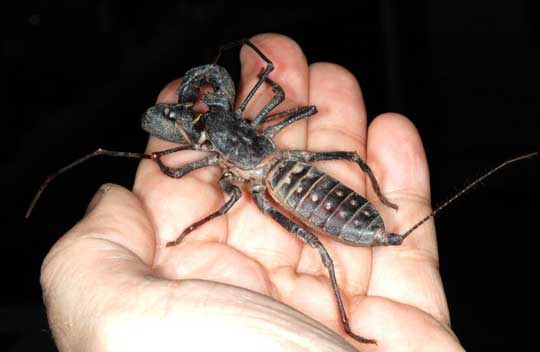
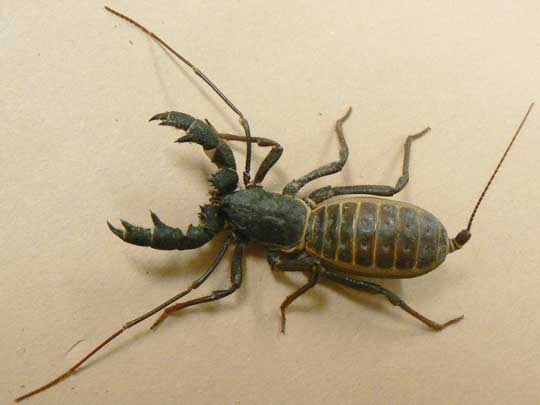
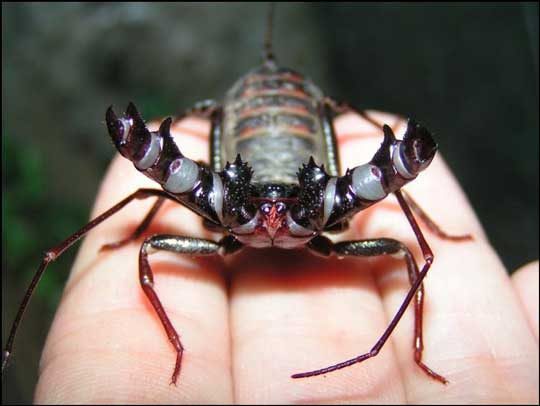
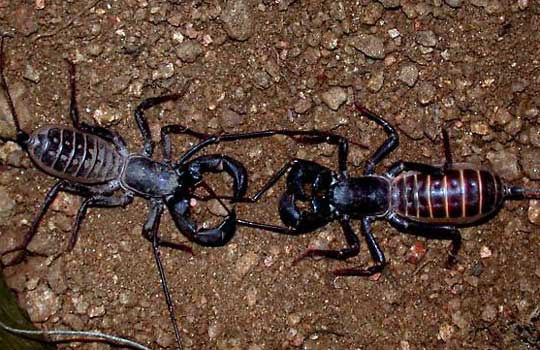
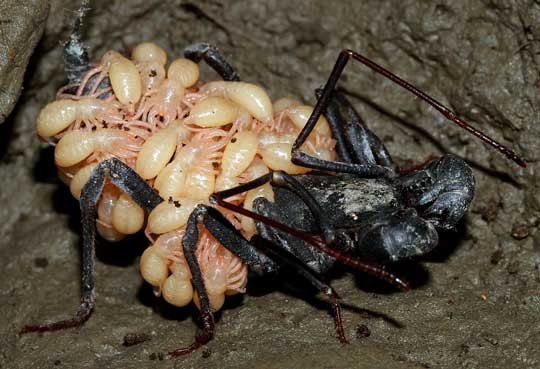
 RSS Feed
RSS Feed